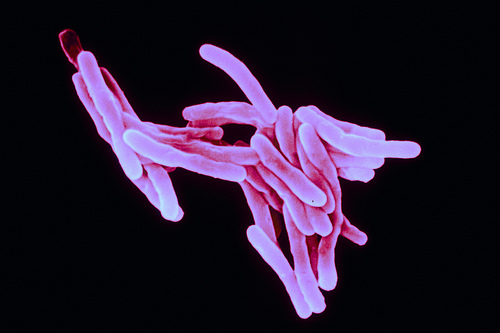This page is part of our special coverage Global Development.
The Indian media and blogosphere have been locked in fierce battle over two words: “extensively,” and “totally.” If you’ve been following Indian news at all, you know that it is about the global health community’s tuberculosis debate.
India’s media sphere exploded last week with reports from Mumbai of a tuberculosis strain completely resistant to all known treatment. The Indian newspapers coined it “totally drug-resistant tuberculosis” or TDR-TB. But just a few days later the Government of India released a statement refuting the term TDR-TB, saying that the World Health Organization has no clear definition for TDR-TB, and that the TB emerging in Mumbai, India is merely another strain of extremely drug-resistant TB (XDR-TB). They’re now calling it XXDR-TB, or “extensively drug-resistant TB.”

Electron microscope image of mycobacterium tuberculosis, responsible for tuberculosis. Image by Flickr user Sanofi Pasteur (CC BY-NC-ND).
The blogosphere and headlines erupted with experts and Indian citizens wondering why the Government of India and the big players in TB treatment were arguing over what to call it, rather than what to do about it.
Bharati Ghanashyam, a blogger for Journalists Against TB, summed up the outrage that erupted in the global health blogosphere following the Indian Ministry of Health's statement, “Call it any name but banish it.”
Ghanashyam commented that the TDR-TB fiasco arose on the heels of the news that India had been declared polio-free for an entire year. His question: how could India achieve such a milestone but drop the ball so badly with TB? He then noted that there was “considerable debate, denial and discussion on whether this new form can be termed TDR-TB.”
As per a report in the Indian Express, “The doctors from Hinduja have unnecessarily raised a panic alarm. The term TDR is not recognized by the WHO or the Revised National Tuberculosis Control Programme (RNTCP). As of now, they are only slotted as XDR-TB cases,” said an official from the Directorate of Health Services.”
Twitter user TBVI_EU agreed with Ghanashyam:
@TBVI_EU: “So true! @bghanashyam It makes little difference what we call different forms of TB. What matters is people are dying,”
Blogger Alanna Shaikh, an expert in health consulting, got some attention from the development community for her blog post on End the Neglect: and calling the new form “TDR-TB.”
TDR-TB is exactly what it sounds like. Doctors have not yet been able to identify a treatment for this TB that will work,” she wrote. “This is a bad, bad development for global health.
The WHO claims on their website, that there is no way to determine whether strains of TB that appear resistant to drugs in the laboratory, are actually resistant to the drugs in the patient. This may seem counter-intuitive since the 12 patients suffering from a particularly virulent form of tuberculosis in Mumbai have obviously show they are not susceptible to the available drugs, the WHO is simply attempting to state that it lacks a standardized test to determine just how effective different combination of the drugs are in the laboratory vs. treating real patients.
Incidentally, India’s Ministry of Health issued a report on January 20, 2012, stating that nine out of the twelve reported patients were stable on their current treatment while three had died, confirming that the strain is susceptible to some antibiotic treatment.
One thing remains certain, the #tuberculosis Twitter stream and TB online advocacy community are adamant that tuberculosis needs to remain a high-priority for donor governments and international donor organizations like the Global Fund and the United Nations.
This page is part of our special coverage Global Development.







5 comments